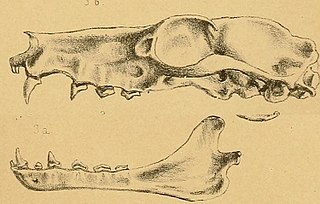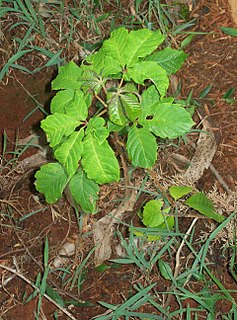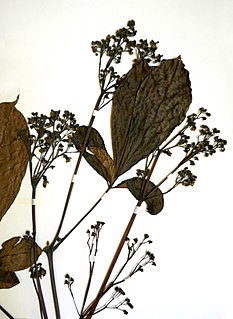
The superb fruit dove, also known as the purple-crowned fruit dove, is a medium-sized, colourful fruit-dove in the family Columbidae.

The red-flanked duiker is a species of small antelope found in western and central Africa in countries as far apart as Senegal and Sudan. Red-flanked duikers grow to almost 15 in (35 cm) in height and weigh up to 31 lb (14 kg). They have russet coats, with greyish-black legs and backs, and white underbellies. They feed on leaves, fallen fruits, seeds and flowers, and sometimes twigs and shoots. The adults are territorial, living in savannah and lightly wooded habitats, and the females usually produce a single offspring each year. They have lifespans of ten to fifteen years in captivity.
The Kern Plateau salamander is a species of salamander in the family Plethodontidae, endemic to California, in Tulare and Inyo, and Kern Counties in the western United States.

The gracile naked-tailed shrew is a species of mammal in the family Soricidae. It is found in Burundi, Gabon, Kenya, and Uganda. Its natural habitat is swamps.

The Ugandan lowland shrew is a species of mammal in the family Soricidae. It is found in Kenya and Uganda. Its natural habitats are subtropical or tropical swamps and subtropical or tropical moist montane forest. It is threatened by habitat loss.

The Angolan epauletted fruit bat is a species of megabat in the family Pteropodidae. It is found in Angola and Namibia. Its natural habitats are dry savanna and moist savanna. It is threatened by habitat loss.
Vitex acunae is a species of plant in the family Lamiaceae. It is endemic to Cuba. It is threatened by habitat loss.
Vitex ajugaeflora is a species of plant in the family Lamiaceae. It is endemic to Vietnam.
Vitex amaniensis is a species of plant in the family Lamiaceae. It is endemic to Tanzania.
Vitex cooperi is a species of plant in the family Lamiaceae. It is found in Costa Rica, Guatemala, Honduras, Nicaragua, and Panama.
Vitex evoluta is a species of plant in the family Lamiaceae. It is endemic to New Caledonia.

Vitex gaumeri is a species of plant in the family Lamiaceae. It is found in Belize, Guatemala, Honduras, and Mexico.
Vitex heptaphylla is a species of plant in the family Lamiaceae. It is found in Cuba, Dominica, the Dominican Republic, and Haiti.

Vitex keniensis is a species of plant in the family Lamiaceae.
Vitex kuylenii is a species of plant in the family Lamiaceae. It is found in Belize, Guatemala, Honduras, Mexico, and Nicaragua.

Vitex lehmbachii is a species of plant in the family Lamiaceae. It is endemic to Cameroon. Its natural habitat is subtropical or tropical moist lowland forests. It is threatened by habitat loss.
Vitex longisepala is a species of plant in the family Lamiaceae. It is a tree endemic to Peninsular Malaysia.

Vitex parviflora is a species of plant in the family Verbenaceae, also known as smallflower chastetree or the molave tree. It is found in Indonesia, Malaysia, and the Philippines. It is threatened by habitat loss. The name "molave" is from Spanish, derived from Tagalog mulawin. It is also known as tugas in Visayan languages.
Vitex urceolata is a species of plant in the family Lamiaceae. It is a tree endemic to Peninsular Malaysia. It is threatened by habitat loss.
Vitex zanzibarensis is a species of plant in the family Lamiaceae. It is found in Kenya and Tanzania. It is threatened by habitat loss.









